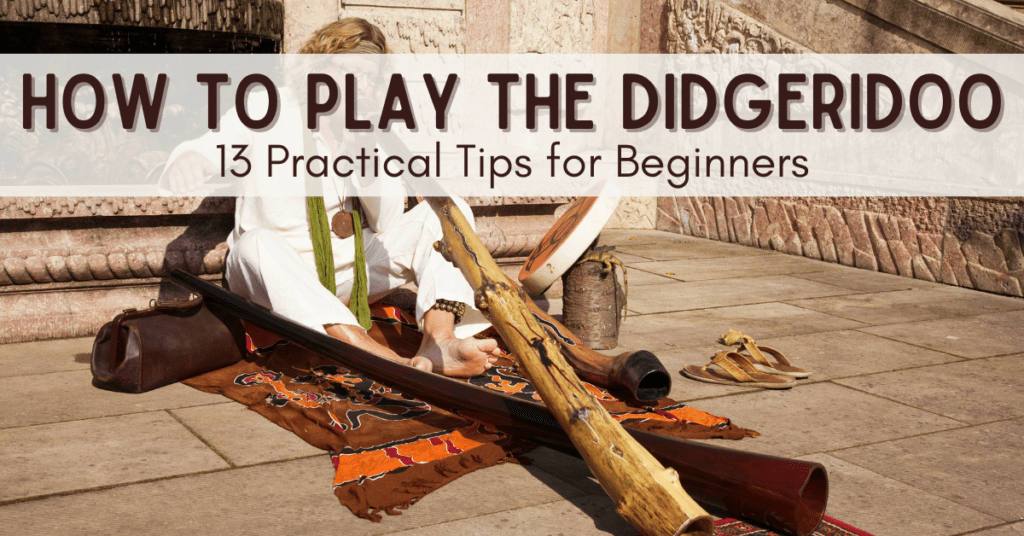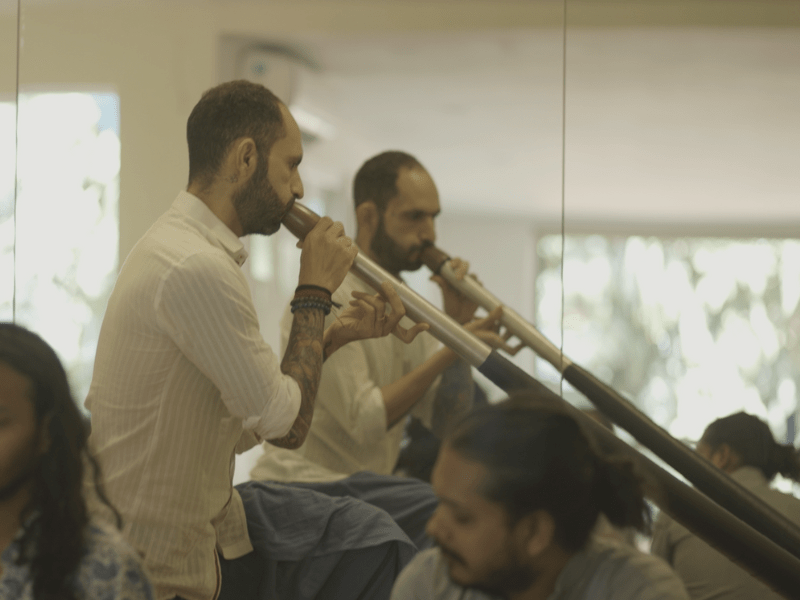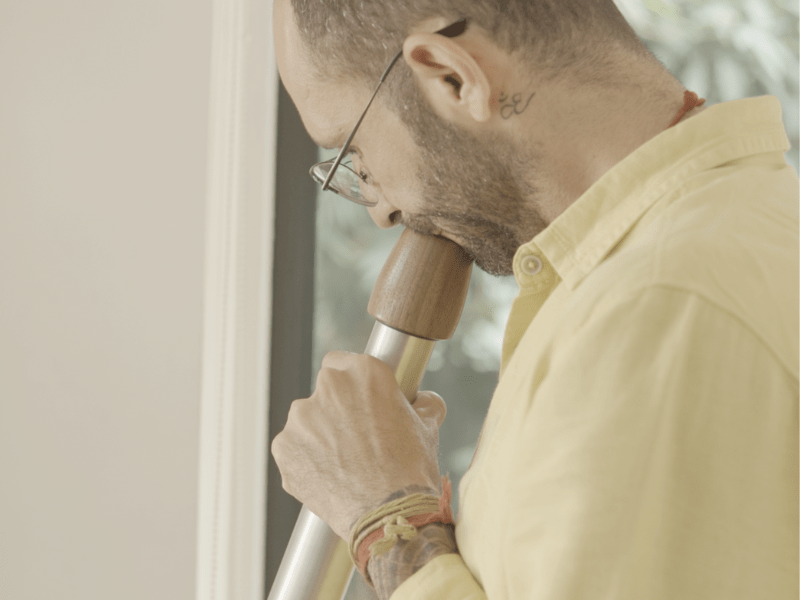How to Play the Didgeridoo: 13 Practical Tips for Beginners
Learn how to play the didgeridoo with practical tips for beginners. Explore helpful techniques and start practicing today!

The didgeridoo is an intriguing and unique instrument to learn. It has a distinct sound and a rich cultural heritage that originated from the Aboriginal people of Australia. If you’ve ever wondered how to play the didgeridoo, you’re in the right place!
In this guide, we’ll explore practical tips and techniques for beginners, helping you start your journey with this ancient instrument. Whether you’re drawn to its meditative drone, its cultural significance, or simply the unique challenge it presents, learning to play the didgeridoo is a deeply satisfying experience.
As a musician who started learning how to play the didgeridoo five years ago, I’ve experienced firsthand the joy and challenges it brings. But, it’s well worth the effort and practice to learn.
From mastering the basic drone to exploring more advanced techniques like circular breathing, we’ll cover everything you need to know to get started.
This post is all about how to play the didgeridoo.
What is a didgeridoo?
The didgeridoo is one of the oldest musical instruments in the world, with roots deeply embedded in the cultural and spiritual traditions of the Aboriginal people of northern Australia. Traditionally made from native eucalyptus trees naturally hollowed out by termites, the didgeridoo has been played for over a thousand years.
The instrument was and still is used in ceremonial gatherings, storytelling, and dance rituals, often accompanied by singing and other percussion instruments.
Playing the didgeridoo involves producing a continuous drone sound by vibrating the lips against the mouthpiece. This fundamental sound is then enhanced with various techniques, including circular breathing, vocalizations, and rhythmic variations.
In modern times, the didgeridoo has gained popularity worldwide, embraced by musicians across various genres for its unique sound and meditative qualities. It is now crafted from various materials, including bamboo, agave, and synthetic composites, making it more accessible while still honoring its traditional origins.
The didgeridoo’s distinctive sound and profound cultural significance make it a fascinating instrument that continues to inspire and resonate with people around the globe.

How to Play the Didgeridoo
#1 Find the Right Position
To start, find a comfortable spot where you can sit down and relax. Hold your didgeridoo in front of you, letting it rest gently on the ground. If you prefer to stand, tilt the didgeridoo slightly downward.
Then, place one hand securely around the mouthpiece and let the other hand support the length of the instrument. This helps ensure you have a firm yet gentle grip.
Make sure you feel balanced and comfortable, as this will help you focus on producing a steady, resonant sound. Playing the didgeridoo should feel natural and enjoyable, so take a moment to find a position that feels just right for you.
#2 Practice Buzzing (without didgeridoo)
Before you start playing the didgeridoo, take a moment to get comfortable with the sensation of buzzing your lips. This step is crucial for producing that signature drone sound.
Imagine you’re making a playful raspberry sound or blowing a gentle, steady stream of air through your lips. Without the didgeridoo, simply press your lips together loosely and blow, creating a buzzing vibration.
Think of this as a warm-up exercise. You can practice this buzzing until it feels natural and easy. You might feel a bit silly at first, but this simple exercise will help you develop the control and muscle memory needed for playing the didgeridoo.
Plus, it’s a great way to get your lips and facial muscles relaxed and ready for when you play. Remember, the more relaxed and comfortable you are with buzzing, the better your didgeridoo sound will be.
#3 Cover the Entire Mouthpiece
Gently bring the mouthpiece to your lips and make sure you’re covering the entire mouthpiece. Make sure your lips are relaxed and not too tight. If they’re too tight, you’ll struggle to produce a good sound; too loose, and you’ll lose the seal. It’s all about finding that sweet spot.
Here is a little trick to try… Puff your cheeks slightly to create some space and then press your lips lightly against the mouthpiece. This can help you find the right amount of pressure.
#4 Relax Your Lips
Keeping your lips relaxed is key to creating a beautiful, resonant drone on the didgeridoo. If your lips are too tight, you’ll find that the sound gets strained or doesn’t come out right.
A great way to find this balance is to start by making that buzzing sound mentioned earlier without the didgeridoo. Feel how your lips vibrate freely when they’re not overly tense.
As you bring the didgeridoo to your mouth, maintain that same relaxed feeling. Let your lips sit comfortably against the mouthpiece, not too loose but certainly not rigid.
If you’re feeling a bit tense, take a deep breath and shake it out. Sometimes it helps to take a moment, close your eyes, and just breathe deeply, allowing your whole face to relax. Remember, the didgeridoo is an extension of your breath and your body’s natural rhythm. The more relaxed you are, the more harmonious the sound will be.
#5 Practice the Drone Sound (a steady, continuous sound)
This is the heart and soul of playing the instrument. It’s the fundamental sound of the didgeridoo and one of the most important skills to practice when you begin learning how to play the didgeridoo.
First, take a deep, calming breath. Then, with your lips gently pressed against the mouthpiece, blow the air out through your relaxed lips to create a buzzing sound.
Your goal here is to produce a continuous, steady sound.
A helpful tip is to focus on your breath control. Imagine you’re blowing a gentle but consistent stream of air, like you’re trying to move a feather without letting it fall. This steadiness is key to maintaining a smooth drone.
Practice this a lot when you’re just starting out. Getting comfortable with it will open up all sorts of creative possibilities as you progress. Set aside a few minutes each day to work on your drone. It’s a great way to unwind and center yourself, too.
#6 Experiment with Your Tongue and Cheeks
After you’ve got the hang of the basic drone, it’s time to add some flair to your playing by experimenting with your tongue and cheeks. This is where you can really start to have fun and get creative with your didgeridoo sounds.
By changing the pressure and shape of your mouth, you can create all sorts of interesting variations and rhythms.
Start by inflating your cheeks slightly. Then, gently push the air out using your cheek muscles. Notice how this changes the sound of the drone.
Next, try moving your tongue around inside your mouth. Try touching the roof of your mouth, moving your tongue to the sides, or even creating a wave-like motion. Each movement will create a unique sound, giving your didgeridoo playing its own style as you advance.
The didgeridoo is all about exploration and expression. The more you play around with your tongue and cheeks, the more you’ll discover the endless possibilities of sounds you can create. There’s really no right or wrong way to do this, just have fun with it.

#7 Try Vocalizations
Vocalizations are another way to change the sound of the didgeridoo and get creative. You can vocalize while playing to add different textures and effects.
While maintaining the drone, try making different vocal sounds. You can hum, growl, or even speak softly into the didgeridoo. Notice how your voice merges with the drone to create new sounds.
Start with a simple hum. As you play the drone, hum a gentle note and feel the vibrations mix together. Experiment with different pitches and tones.
Then, you can try other sounds like a growl or a small shout. Each sound you make will interact uniquely with the drone, giving your music a dynamic and expressive quality.
Don’t worry about sounding perfect. The beauty of vocalizations is in their raw, authentic expression. You’re adding a piece of yourself to the music, making it truly unique. Once you’re comfortable, you can also try imitating natural sounds, like a bird chirping or ongoing thunder.
The more you experiment as you learn how to play the didgeridoo, the more you’ll discover how vocalizations can enhance your didgeridoo playing. It’s a great way to connect more deeply with the instrument and express your emotions through sound.
#8 Take Deep Breaths
Breathing is the heartbeat of didgeridoo playing, and mastering it can make all the difference. Take time to focus on your breathing. Take a deep, steady breath in through your nose, letting your chest and belly expand fully.
Breath control is essential for keeping the drone going. The key here is to maintain a calm, consistent breath. Practice taking long, slow breaths and exhaling steadily.
You can even practice this without the didgeridoo at first. Place your hand on your belly and feel it rise as you inhale and fall as you exhale. This helps ensure you’re using your diaphragm to support your breath.
As you become more comfortable, try experimenting with the length and intensity of your breaths. Notice how slight changes affect the sound and find what works best for you. The more you practice, the more control you’ll gain over your breath, allowing you to play longer and more consistently.
#9 Listen to Experts
One of the best ways to enhance your didgeridoo playing is by immersing yourself in the sounds and techniques of skilled players. Start by finding recordings of renowned didgeridoo artists. Put on your headphones or find a quiet space, and really listen. Notice the variety of tones, rhythms, and textures they create. (Lewis Burns is one of my favorite didgeridoo artists if you’re looking for recommendations).
Pay attention to the nuances of their playing, the way they control their breath, the subtle movements of their tongue and cheeks, and the integration of vocalizations.
As you listen, try to pick out specific techniques that stand out to you. Maybe it’s a particular rhythm that catches your ear or a unique sound effect that intrigues you. Don’t worry about understanding everything at once. The goal is to soak in the music and get inspired.
Listening to experts can also help you develop your own style. By hearing how others play, you’ll discover new possibilities and ideas to incorporate into your practice.
You can also watch videos of didgeridoo performances. Notice how they hold the didgeridoo, their posture, and how they use their facial muscles to shape the sound.
And don’t be shy about reaching out to the didgeridoo community. Many skilled players are happy to share tips and advice. Join online forums, attend workshops, or even connect with other players in your area. Being part of a community can provide support, encouragement, and new learning opportunities.
#10 Imitate Sounds
Try to imitate the sounds you hear in recordings to learn new techniques and styles. Don’t worry about getting it perfect right away, it’s more about experimenting when you’re starting how to learn the didgeridoo.
Play along with the recordings, mimicking the sounds as closely as you can. Notice how the players use their breath, lips, tongue, and cheeks to create different effects.
If you hear a particular rhythm or vocalization that you like, try to incorporate it into your own playing. Over time, you’ll develop a deeper understanding of various techniques and how they can be used to enhance your own style.
The goal is not to become a carbon copy of another player, but to use their music as inspiration.
#11 Practice Circular Breathing (More Advanced)
Once you are able to produce consistent drone sounds, circular breathing is the next crucial skill to practice. It’s what allows you to maintain a continuous drone without pausing for breath.
First practice circular breathing without the didgeridoo. You can use a straw and a glass of water to help in the beginning.
Start by placing the straw in the glass of water and take a deep breath. Now, puff out your cheeks as if you’re storing air in them. The trick here is to use your cheek muscles to push air out through the straw, creating bubbles in the water, while you simultaneously inhale through your nose.
It might feel awkward at first, and that’s completely normal. The key is to keep the airflow steady, even as you switch between mouth and nose breathing.
As you practice how to play the didgeridoo, you’ll start to build the muscle memory and coordination needed for circular breathing. This technique takes time to master. Try practicing for a few minutes each day, and gradually increase the duration as you become more comfortable.
#12 Try Short Bursts of Circular Breathing
Circular breathing can feel like a big challenge at first. After you practice without the didgeridoo, then start by practicing in short bursts with the instrument.
First focus on producing a steady drone on your didgeridoo. Once you’re ready, start incorporating short bursts of circular breathing. Aim for just a second or two at first.
Practice these short bursts several times in a session. As you get more comfortable, gradually extend the duration of your circular breathing. Maybe add another second or two each time you practice. Every successful burst of circular breathing is a step forward.
Pay attention to how your body feels and adjust accordingly. It’s important to stay relaxed and not force it. Also remember, the key is consistency. Regular practice will help you master circular breathing, even if it’s short sessions.
#13 Be Patient!
Learning how to play the didgeridoo, especially mastering circular breathing, is a journey that requires time and patience. Remember, every great player started right where you are now, learning the basics and building their skills step by step.
It’s easy to get frustrated when things don’t click right away, but patience is your best friend on this journey. Understand that developing the techniques and muscle memory for the didgeridoo takes consistent practice and time.
Celebrate small victories along the way. Maybe today you managed a few seconds of circular breathing or produced a more consistent drone, these are all steps in the right direction. Acknowledge your progress and keep moving forward.
So, take it easy on yourself. Be patient, stay relaxed, and most importantly, have fun.
This post was all about how to play the didgeridoo.



